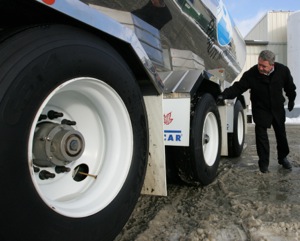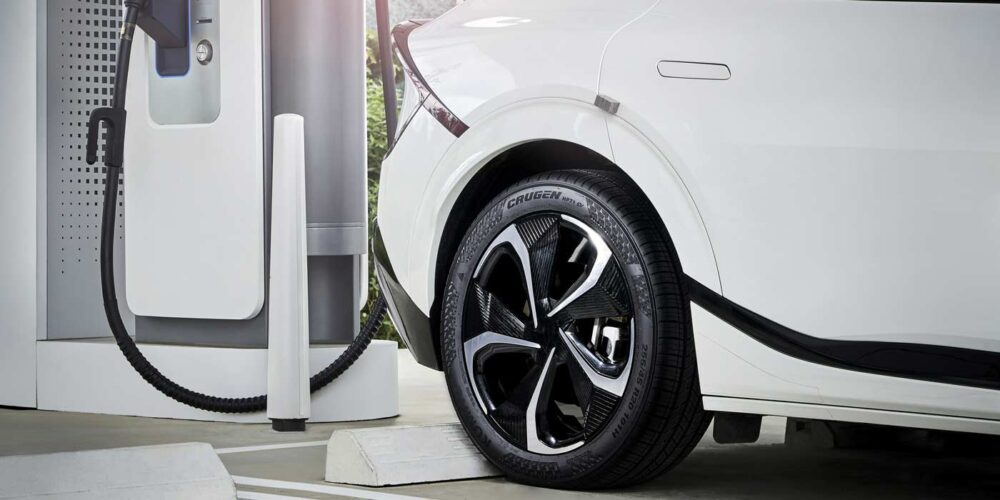 Talk to any commercial fleet manager and he will tell you the same story: it’s all about maximizing vehicle fuel economy. And more than ever, tires play a significant role in helping fleets achieve their fuel economy objective.
Talk to any commercial fleet manager and he will tell you the same story: it’s all about maximizing vehicle fuel economy. And more than ever, tires play a significant role in helping fleets achieve their fuel economy objective.
Of course fleets also want to maximize their tire removal miles, but when you do the math it is quite apparent that improved fuel economy far outweighs any loss in tire removal miles sometimes associated with fuel-efficient tires.
Diesel fuel prices remain in the $4 per gallon price range and tire prices continue at record highs. Fleets want to evaluate the latest and greatest fuel-efficient tires available in the marketplace to determine which tires might be the best investments for their operations.
In some cases, more fuel-efficient tires have less initial tread depth versus their equivalent standard design tire. If a fleet currently averaging 15,000 miles per 32nd on its line haul drive tire with a starting tread depth of 30/32nds switches over to a fuel-efficient drive design that may only have 26/32nds of rubber, the fleet will certainly see a reduction in tire removal miles. In this case, a straight reduction of 4/32nds in starting tread will equate to a drop of 60,000 miles.
While the above example does not take into account the potential positive mileage impact of a fuel-efficient tread, this is still a lot of miles. A lot, that is, until you look at the potential vehicle fuel savings – between 1% and 4% – when spec’ing the fuel-efficient drive tire option. Then it makes complete sense why fleets would prefer the fuel economy improvement over any lost removal mileage.
Doing the Math
Let’s assume a fleet has 100 trucks that travel 100,000 miles per year and currently average 6 mpg with the control, or non-fuel-efficient, tires. Let’s also say that conservatively, the fleet is only seeing a 2% improvement in fuel economy when it switches to fuel-efficient tires. That 2% fuel economy improvement bumps the fleet average to 6.12 mpg.
At 6 mpg, one truck will consume 16,667 gallons annually when driving 100,000 miles on the control tires. At 6.12 mpg, the same truck with fuel-efficient tires will consume only 16,339 gallons of fuel – a savings of 328 gallons per year for each truck in the fleet. For 100 trucks, that’s a savings of 32,800 gallons of fuel.
At $4 per gallon, the savings going directly to the fleet’s bottom line is $131,200.
When you inform the fleet manager that the fuel-efficient tire has a 10% price premium (it may be higher or lower), he should not balk when you run that calculation.
Let’s now assume the control drive tire has a cost of $400 and the fuel-efficient version with 4/32nds less rubber is $440 per tire. The fleet has test data from its own internal testing, which shows the control tires average 300,000 removal miles, while the lower tread depth fuel-efficient design yields 270,000 miles to removal. Eight non-fuel-efficient drive tires will cost $3,200 per truck. Fuel-efficient drive tires cost $3,520 per vehicle.
The cost per mile of the fleet’s control tires is $3,200 divided by 300,000 miles, or $0.011. The fuel-efficient tire cost per mile – $3,520 divided by 270,000 – is $0.013.
A Step Further
The final calculation demonstrates that even with a 10% price premium associated with the fuel-efficient tires and a loss in removal miles, fuel-efficient tires are still a win-win investment. (It is important to mention that some new fuel-efficient tires entering the market claim little or no loss in removal miles.)
Over a three-year time period, the 100 trucks will each travel 100,000 miles per year, or 300,000 miles. At a 2% fuel economy improvement with fuel-efficient tires, the fleet will save $131,200 per year, or $393,600 over this three-year period.
Now assume a worst-case reduction in removal miles of 10%, resulting in a cost per mile increase of $0.002 ($0.013 – $0.011 = $0.002). The fleet will be paying $352,000 (100 trucks x 270,000 miles x $0.013) over the three-year period for their fuel-efficient drive tires. Their original standard tires cost $330,000 for this same three-year period (100 trucks x 300,000 miles x $0.011).
The bottom line is that the added cost for the fuel-efficient tires was $22,000 over three years. But the 2% fuel economy improvement with these tires saved $393,600 for the 100 trucks during those three years.
Even at a worst-case loss of 10% in removal miles, it is clear that fuel economy improvement with the higher priced fuel-efficient tires delivers the biggest bang for the buck. If a fleet can spec tires with a fuel economy improvement and no loss in tire miles, then the payback is even greater.
Delivering the Message
So what is the best way to work with your fleet customers to demonstrate the win-win capability of fuel-efficient tires?
There are two types of fuel economy test procedures a fleet can run without too much difficulty: Type II and Type III evaluations, which are well-documented as approved recommended practices or procedures through SAE and TMC (Technology & Maintenance Council of the American Trucking Associations). It is important to understand the nuances of and differences between each of these test procedures.
The Type II procedure uses a control truck that is not modified in any way during the actual test. You begin with a control tractor/trailer equipped with the fleet’s baseline tires in all the wheel positions. The fuel consumption rate of this control vehicle is used to generate baseline data from running under real world conditions during the test period.
The test vehicle (different from the control vehicle) is first equipped with the same tires as the control vehicle. This will determine the vehicle effect on fuel economy.
Phase two is to replace the tires on the test tractor/trailer with fuel-efficient tires. The actual fuel economy calculation is documented by the Recom- mended Practice 1102 issued by TMC. It is strongly recommended to physically weigh the fuel tank before and after the evaluation to be most accurate in determining the actual miles per gallon.
When using a Type III fuel economy test, choose two identical vehicles. Vehicle A is equipped with the control tires, while Vehicle B is running the fuel-efficient tires. The test consists of two runs, or segments. In the first segment, Vehicle A runs the control tires and Vehicle B runs the fuel-efficient tires. In the second, the tires are swapped between the two vehicles. Further details on the specifics can be found in TMC RP-1103.
Commercial tire dealers must fully understand exactly how fuel-efficient tires are a win-win for everyone. Fleets can reduce their operating costs despite the initial higher price premium associated with fuel-efficient tires.
Fleets are OK with paying more for their tires when a clear fuel economy improvement can be demonstrated, especially when there is little loss in removal mileage.
This is where being knowledgeable on calculating cost per mile and running fuel economy evaluations is so important.













